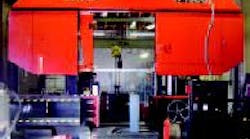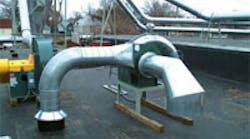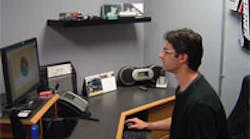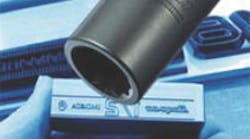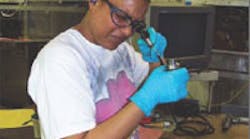The H1300 bandsaw, one of four Amada saws at PMC Machining, incorporates a band-deviation monitor that lets the shop set fast, economical cutting rates.
PMC Machining relies on four saws from Amada for cutting tough materials like chromium and chromium alloys, titanium CP grade, nickel-chromium alloys, zinc, and 304/316 stainless steel.
Phoenix-based PMC Machining manufactures and machines products for the flat-panel and display industries. The shop works with tough materials and does its sawing inhouse, keeping three bandsaws and a plate saw running 20 hr/day, 6 days/week.
The four saws, an H1300, HA700, HFA250W, and VM3800, are from Amada Cutting Technologies. With them, PMC cuts such materials as chromium and chromium alloys, titanium CP grade, nickelchromium alloys, zinc, and 304/316 stainless steel.
According to Mark Porter, PMC president, the H1300 bandsaw's 52-in.-diameter capacity is useful for cutting various bar cross-sections to length. The shop watches blade position during cuts on the saw's band-deviation monitor and adjusts for fast economical cutting rates from real-time blade-deviation readings.
PMC relies on the HA700 for large cutting jobs, those up to 28 in. in diameter. "The bandsaw eliminates manual material positioning and blade-height adjustment," states Porter. "With its automatic indexing, we set up programmable dimensions without worrying about operator error. We simply set the back gauge counter to the number of desired pieces and required cut length, and the saw delivers continuous accurate cutting with a minimum of noise," he adds.
The HFA250W at PMC tackles the shop's high-production round cutting of high-purity alloys, titanium, and carbide. A key feature of the saw is its NC index controller, which gives PMC greater flexibility and expanded capabilities as compared to a machine with relay logic.
Using the controller, PMC operators specify the index home position — forward and clamped or at the index position for open. The controller also determines index vice motion forward and reverse and allows for independent ramp cycles for the forward and rear traverse. Speed ramp up and down for moving the workpiece is slower during part positioning as compared to when it is moving without work. This ensures accurate indexing of the part.
PMC uses its VM3800 plate saw for the same product lines it cuts on the HA700. With a 130-in.-length capacity, the VM3800 lets the shop easily maintain a 36 3 130-in. depth of cut.
The plate saw provides smooth, pulse-free operation with high torque at table speeds as slow as 0.1 ipm and rapid table positioning up to 19.7 ft/min. It excels at cutting materials like titanium, difficult alloys of stainless steels, or workhardened tool steels when thicknesses are close to its maximum height of 24 or 32 in., says Porter.
Amada Cutting Technologies
La Mirada, Calif.
amadabandsaw.com
Job-based system rids shop of ERP headaches
"Scheduling is 150% better, and we can enter data on-the-fly since implementing the JobBoss ERP system," says Vicky Jacobs, a manager at AP&D.
The JobBoss ERP system offers finite scheduling by workcenter, so AP&D achieves smooth workflow while using machines, people, and assets to the fullest.
American Punch and Die (AP&D), a shop that manufactures and repairs tooling for automotive dies, was having problems with its enterpriseresourcesplanning (ERP) system. The Cadillac, Mich., shop's main complaint was that the system, which was more production-based than jobbased, did not allow for adding data on-the-fly. Fortunately, switching to a JobBoss ERP system gave the shop this capability and more.
JobBoss is a job-based system specifically for, as its manufacturer says, the make-to-order, chaotic, change-driven environment of today's jobshops. Its finite scheduling by work center lets AP&D immediately update schedules and dependencies to integrate inside operations with outside ones and to purchase material with the updated schedule. On multilevel component jobs, the shop coordinates the routing and material requirements in accordance with changed due dates or quantities.
"Scheduling is 150% better," says Vicky Jacobs, a manager at AP&D. "We actually see where things are and where they are going. Time entry is vastly improved, and I add workcenters on-the-fly if routings change," she says.
With JobBoss, Jacobs also changes part numbers when necessary. For instance, when ordering the same steel for two different jobs, Jacobs previously issued a new purchase order for the second job. But now, part masters are no longer required for everything, she says, so there are no queue-time problems.
When there was, for instance, an 8-hr wait at a machine/workcenter, the shop's old system added it as actual mill or grind time for the job, which resulted in inaccurate costs. JobBoss accommodates this queue time.
In addition to its flexibility, JobBoss' finite scheduling by workcenter, Jacobs believes, lets AP&D achieve a smoother work flow while using machines, people, and assets to the fullest. Purchasing is linked to the job schedule, and time remaining on the job is influenced by time already reported, she adds.
Exact Software
Minneapolis
jobboss.com
Company goes with nontraditional CNC
Lewa Attendorn teaches its universal sheetmetal and profile, 12-to-16-axis stretch-bending machines complex 3D programs using a panel PC and soft-PLC setup from Siemens.
Lewa Attendorn GmbH, Germany, "teaches" its universal sheetmetal and profile, 12-to-16-axis stretch-bending machines complex 3D programs using a panel PC and soft-PLC setup instead of traditional CNC. For the automotive supplier, the combination, in the automatic mode, controls the intensive data traffic to special hydraulic-control modules and delivers precise, reproducible, and crease-less bending.
The company's system incorporates distributed intelligence through the industrial Panel PC 670 from Siemens' Simatic HMI series. This central HMI uses ProTool/Pro, a configuration and visualization software, also from Siemens.
A Simatic WinAC RTX soft PLC handles all machine functions, covers several other requirements, and runs on a realtimesubsystem for Windows NT. "This is a fast solution without communicationslowing hardware between the HMI system and the PLC," states a design engineer at Lewa. Data from ProTool/Pro — stored in archives — travels to the soft PLC via an OPC interface (OLE for process control).
Another advantage of this pure PC-based software solution is that Lewa can use the Panel PC's entire memory for PLC tasks. The 512-Mbyte Panel PC 670 possesses all current interfaces including Profibus, Multi-Point-Interface (MPI), ethernet (10/100 Mbit), COM (two times), and LPT. This means it integrates into higher-level company networks without additional plug-in cards.
An EB32 electronics module, developed by Siemens Cologne, provides the computing power to control axes positions, forces, and torque values. This module, mounted at the back of the machine, collects the encoder signals of each axis and controls flowrates of the proportional valves via analog signals. Control times are less than one millisecond (for four axes) for a positioning accuracy of 1/100 mm.
The Siemens system's accuracy paid off for one particular application, which involved 3Dformed automotive-window tracks made from U-shaped extrusionmolded aluminum profiles. Even the smallest irregularity — caused by uncontrolled compression of the material — stands out on this part's painted outer surface. So its profile must be controllably stretched and bent to prevent compressions, kinks, or creases from forming.
Siemens Energy and Automation
Elk Grove Village, Ill.
siemenscnc.com
Inserts zap electric-motormachining problems
ATB tackles the hard casting skins, varied casting allowances, and sand inclusions (cutting interruptions) of cast iron end plates for electric motors with Tiger-Tec universal indexable inserts.
Machining cast iron end plates for electric motors proved a costly undertaking for ATB Antriebstechnik AG. Hard casting skin, varied casting allowances, and sand inclusions (cutting interruptions) shortened cutting tool life, slowed machining times, and increased machine downtime. To eliminate these problems, the electric-motor manufacturer incorporated inserts with a coating specifically for machining cast iron.
The universal indexable inserts, Walter's Tiger-Tec tools, are wear resistant and deliver process reliability over long periods. Their reliable application over a predetermined machining life lets ATB machine operators change cutting edges prior to the end of an insert's calculated useful life.
The result is consistent, high-quality surface finishes and a 50% reduction in insert-procurement costs. The inserts also mount in standard toolholders, which further cuts procurement costs and toollogistics expense.
Tiger-Tec inserts reduce ATB's machine downtime and boost cutting speeds, both of which create additional production capacity on the vertical lathes used to machine the end plates. This, in turn, gives the shop more flexibility to economically manufacture several end-plate variations despite frequent changes and one-piece-batch sizes.
ATB machines end-plate castings ready for installation using turning, drilling, and tapping. Due to variants involved, machine operators must alternate between batch sizes of one and series production of several hundred. So production needs to be flexible with maximum process reliability. Minimizing downtime with Tiger-Tec inserts makes this possible.
The ceramic turning inserts previously used by ATB did provide short machining times, but lacked in process reliability. Cutting edges frequently fractured, ruining the whole insert. All of which made for long downtimes for insert indexing and high material costs because of rapid insert turnover.
Walter Waukesha Inc.
Waukesha, Wis.
walterwaukesha.com
